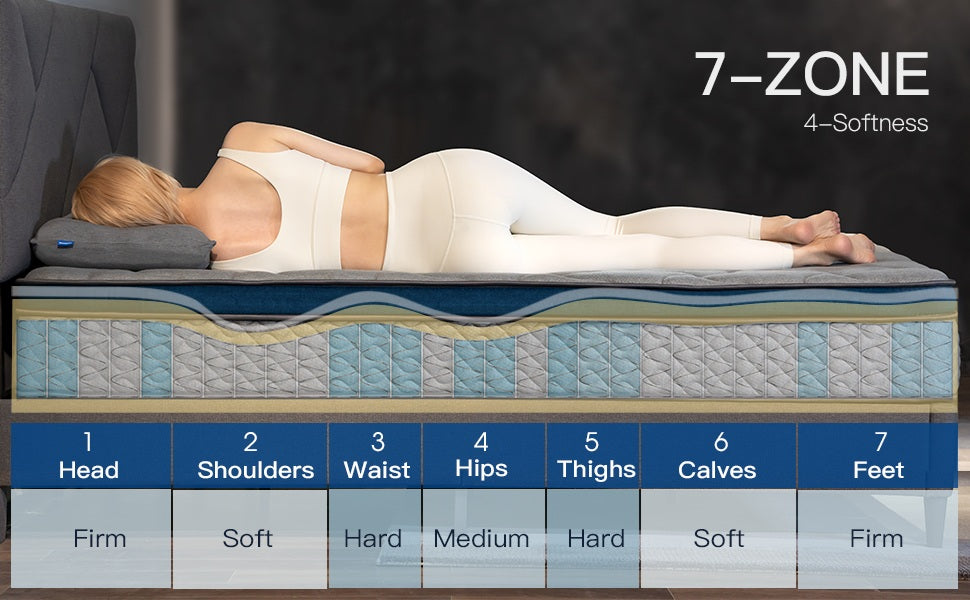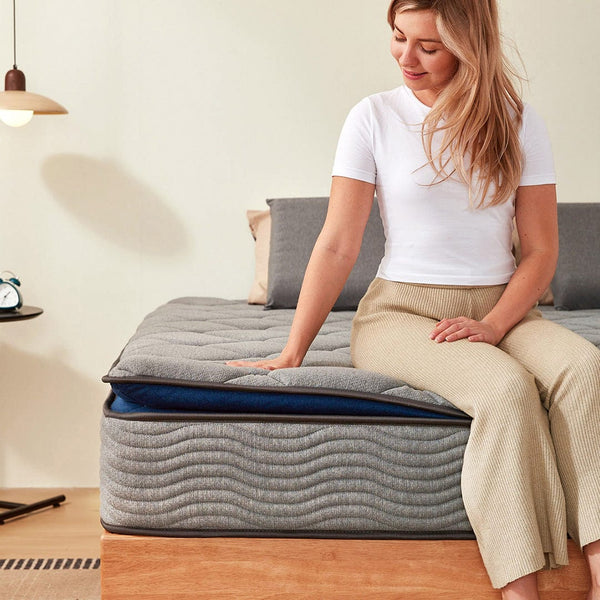A pocket spring mattress is a type of mattress that contains hundreds to thousands of individual springs, each housed in its own fabric pocket. Unlike traditional open-coil mattresses where springs are interconnected, pocket springs work independently. This design allows the mattress to contour to your body's curves, providing support where you need it most.
What is Pocket Spring Mattress? Everything You Need to Know is Here!
Mattresses significantly impact our sleep quality. There are many types of spring mattresses available, but do you know their respective advantages, disadvantages, and differences?
This article will introduce you to the benefits of pocket spring mattresses and their distinctions from Innerspring and Bonnell springs. It will also guide you on how to choose a pocket spring mattress that meets your needs, so don't miss out!

In this article
What is Pocket Spring Mattress?

This means each spring responds separately to pressure, offering more targeted support and better motion isolation.
The Benefits of Pocket Spring Mattress
Provides Zoned Support: Because each pocket spring operates independently, it can offer personalized support to different parts of your body.
Reduces Motion Transfer: When one person gets up during the night, it won't disturb the other person.
Durability: The individual wrapping of the springs helps to reduce wear and tear, making them generally more durable than open coil springs. They can also maintain their shape and support over a longer period.
Good Airflow: The spaces between the individual pocket springs allow for better air circulation compared to some other mattress types. This can help regulate temperature and keep you cooler during the night.
Innerspring vs Bonnell Spring vs Pocket Spring
In the modern mattress market, spring systems are one of the core technologies for the support layer. Traditional innerspring, Bonnell spring, and pocket spring mattresses are three common types, each differing in structure, comfort, and application scenarios. This article analyzes these three spring systems from the perspectives of structure, pros and cons, historical evolution, and comparative features.
Many people may not know the differences between these three types of mattresses, but both Bonnell spring mattresses and pocket spring systems originally evolved from traditional innerspring mattresses.
3.1 The Overview of Structures & Pros & Cons
Traditional Innerspring
(Innerspring)The term "innerspring" broadly refers to mattresses with a metal spring core as the primary support layer. Early traditional innerspring mattresses typically used interconnected designs, where springs were linked via metal wires or frames to form a unified structure. The key characteristic is the high interconnectivity of springs, providing uniform but rigid support.

Pros: Low cost, high breathability, durable
Cons: Noticeable motion transfer, poor contouring, prone to noise
Bonnell Spring
The Bonnell spring is a classic representation of traditional innerspring technology, originating in the late 19th century. Its hourglass-shaped springs—wider at the top and bottom and narrower in the middle—are connected by helical wires to form a mesh. The edges are reinforced with thick steel frames to enhance edge support, while the surface is padded with comfort layers like cotton batting or foam.

Pros: Even support, strong edge reinforcement, cost-effective
Cons: Pressure point discomfort, significant partner disturbance
Pocket Spring
A late 20th-century innovation, pocket spring systems feature individual springs encased in non-woven fabric or cotton pockets. These pockets are glued or stitched together, allowing each spring to move independently. This design provides localized support tailored to body contours.

Pros:Silent operation, motion isolation, superior pressure relief
Cons:Higher cost, potential sagging over time
3.2 Historical Evolution of Innerspring Mattresses
Mid-19th Century: The prototype of spring mattresses emerged, initially used for carriage seats and gradually applied to household furniture.
1871: The Bonnell spring patent was filed, which became mainstream in the 20th century due to its simple structure and low cost.
1990s: Pocket spring technology rose to prominence, catering to consumer demand for quietness and partner-friendly designs, driving growth in the high-end mattress market.
21st Century: Spring technology combined with memory foam, latex, and other materials led to the creation of "hybrid mattresses," further enhancing comfort and support.
3.3 Comparative Summary
| Aspect | Traditional Innerspring | Bonnell Spring | Pocket Spring |
|---|---|---|---|
| Support Mechanism | Rigid, interconnected system | Hourglass-shaped mesh network | Individually responsive pockets |
| Motion Transfer | High | High | Minimal |
| Ideal For | Budget shoppers, firm-bed lovers | Traditional sleepers | Couples, light sleepers, back pain sufferers |
The Best Pocket Spring Mattress You Can Try
Want the minimal motion transfer of pocket springs and the long-lasting durability of traditional Bonnell springs? Try the Newentor Hybrid Mattress Pro. Medium firmness for all sleepers, and this innovative 7 zone pocket spring mattress combines the best of both worlds:
Newentor Hybrid Mattress Pro

FAQs about Pocket Spring Mattress
How long does a pocket spring mattress last?
The lifespan of a typical pocket spring mattress is around 3-5 years.
However, the Newentor Hybrid Mattress Pro has been improved upon the standard pocket spring design by using 3 cm diameter micro coils to replace the comfort layers in most mattresses, which ensures the mattress's longevity.
Therefore, this extends its lifespan to 8-10 years.
How to choose a pocket spring mattress?
When purchasing a pocket spring mattress, consider the following factors:
Check the Spring Count and Quality:
Higher spring counts (800–1,500+ for a queen size) generally offer better contouring and support, especially for heavier individuals.
However, prioritize quality over quantity—poorly made springs with thin wires can sag even in high-count mattresses.
Firmness Level:
Pocket spring mattresses are available in multiple firmness options, and the ideal choice depends on individual factors like body weight, preferred sleep position, and comfort preferences.
Common options include plush (soft), medium firm, and firm settings, though some brands may offer additional variations.
For optimal support, prioritize mattresses with ergonomic designs that incorporate zoned support systems and varied spring types to provide targeted firmness adjustments for different body areas—such as firmer springs for lumbar support and softer ones around the shoulders and hips. This tailored approach enhances spinal alignment and pressure relief.
Warranty and Trial Period:
Having a solid warranty and trial period provides reassurance when buying a mattress.
Being able to try it out at home allows you to make sure it truly fits your comfort preferences.
Certifications:
Ensure foams are CertiPUR-US® or OEKO-TEX® certified to avoid harmful chemicals.
Are pocket spring mattresses noisy?
Pocket spring mattresses are generally quieter than traditional innerspring mattresses.
This is because each spring is individually wrapped in fabric, allowing them to move independently of each other.
This reduces the friction between springs, which is often the cause of noise.
Final Thoughts
Pocket spring mattresses excel in both support and comfort, making them stand out in the mattress market. Understanding their advantages, disadvantages, and differences compared to other mattresses can help you choose a better and more suitable option for yourself. Try Newentor mattress for a more comfortable night's sleep.





















